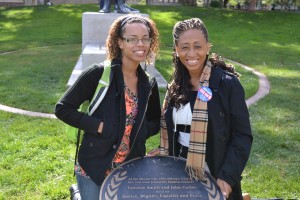Hear more about this story and how it developed on the Peninsula Report podcast.

With early morning sunlight streaming through the door of a packed South Bay Labor Council hall, Elisha St. Laurent did what she had done since the start of the campaign. She stood in front of the room, her 6-year-old son at her side, and told her story.
“I’ve been a single mom for about three years – actually, it’s kind of been forever,” she began, eliciting laughs from fellow volunteers. “It’s been a struggle for me, and there are plenty of people who would know the struggle with me.”
This was the last Saturday before Election Day, a pivotal weekend to fill phone bank stations and hit the pavement for Measure D, the ballot proposal crafted by San Jose State students like St. Laurent that would raise San Jose’s minimum wage from $8 to $10.
On Tuesday night, this grass-roots campaign two years in the making culminated with a decisive victory, garnering nearly 60 percent of San Jose voter support. The passage of Measure D makes San Jose one of the few cities in the country to set its own minimum wage, let alone one as high as $10.
The students championed the cause from start to finish, aided by powerful labor unions and some City Council members while overcoming significant opposition from major business groups, the city’s mayor and other politicians. “Our message was clearly heard by the voters,” said Scott Myers-Lipton, a sociology professor at San Jose State who taught the class where the idea for the measure originated. “It was a big victory.”
Those opposed to the measure, however, are concerned about the ramifications that raising the minimum wage could have on the San Jose economy. “I was disappointed, but not surprised,” San Jose Silicon Valley Chamber of Commerce President Matt Mahood wrote in an email interview. “This was a feel-good issue for the voters, and they voted with their hearts, not necessarily their minds. … It is bad for business in the city of San Jose, and I just don’t think the average voter understands the issue.”
The campaign originated with San Jose State sociology major Marisela Castro in fall 2010, when she took Myers-Lipton’s “Wealth, Poverty and Privilege” class. At the same time, she worked at a middle school, where she noticed some children struggling behaviorally and academically because their parents were working multiple jobs to make ends meet.
“There was a boy I was particularly close with that hadn’t seen his father in about a week because he’d been working two minimum wage jobs and they were barely making it,” Castro said. “[The boy] was having really bad behavioral issues and was starting to do really bad in school.”
Castro enrolled in Myers-Lipton’s “Social Action” sociology class in spring 2011, where she started researching minimum wages in other major cities. She was inspired by San Francisco’s campaign to raise its minimum wage through a proposition passed by voters in 2003, and from there she enlisted classmates to help.
Hearing what Castro witnessed at the middle school inspired Diana Crumedy, a recent San Jose State sociology graduate, to get involved. “Marisela’s story is a tear-jerker,” Crumedy said. “The second I heard, I knew I wanted to do something.”
St. Laurent, a San Jose State senior double majoring in behavioral science and sociology, took Myers-Lipton’s “Social Action” course in fall 2011 and got involved in the campaign through motivation from her experiences as a single mother balancing school with a minimum wage job.
“You’re basically choosing between education and working,” St. Laurent said. “Do you give your child a better life or go to school and get that degree and just struggle all the way?”
After qualifying for the ballot by collecting 35,000 signatures (19,000 were needed), students recruited more volunteers from the student community, San Jose residents, faith organizations, unions and activist groups. They spent evenings at the South Bay Labor Council phone banks, went precinct walking on Saturdays, and passed out fliers.

On a Thursday evening as the election grew near, the Labor Council office was a hive of activity. In one room, baby boomers and college students congregated over trays of pupusas before going back to the phones for Proposition 30, the statewide tax initiative to raise funds for public education which also ultimately passed. In another, volunteers phoned residents in Vietnamese.
Crumedy and Myers-Lipton sat in the same row of computers in yet another room, scrolling through voter registration lists and speaking into their headsets. Around them, a bell would occasionally ding, signaling an affirmation for Measure D from a caller.
“We’re just the regular folks,” Myers-Lipton said as he sat in the cubicle before kicking off the phone bank. “They have four or five opponents that have a ton of money fighting this battle.”
In addition to Mahood and the Chamber of Commerce, Measure D opponents included San Jose Mayor Chuck Reed and the California Restaurant Association. Opponents said the pro-D campaign miseducated people with claims that San Jose would lose up to 3,100 jobs if the measure passed. That estimate came from a survey conducted by Beacon Economics, an independent economic research and consulting firm, and paid for by the California Restaurant Association. During the campaign, the two sides clashed over the validity of that survey.
Now that Election Night celebrations are in the rearview mirror, Measure D supporters are reflecting on their experiences and what the future may hold.
“I was just amazed that all the hard work finally came through,” St. Laurent said. “People are going to be able to shop now, go out to eat and do things they weren’t able to do before.”
